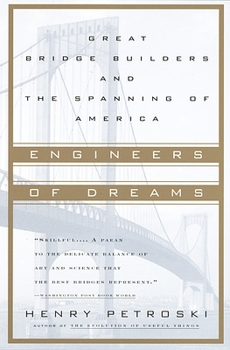Engineers of Dreams: Great Bridge Builders and the Spanning of America
Select Format
Select Condition 
Book Overview
With 131 illustrations in text. This description may be from another edition of this product.
Format:Paperback
Language:English
ISBN:0679760210
ISBN13:9780679760214
Release Date:October 1996
Publisher:Knopf Doubleday Publishing Group
Length:496 Pages
Weight:0.90 lbs.
Dimensions:1.0" x 5.2" x 8.0"
Customer Reviews
5 ratings
BridgePros Review
Published by Thriftbooks.com User , 22 years ago
If you want to learn more about the best American bridge designers and their bridges, this is the book for you! In particular it has a very good chapter on Steinman (the designer of the Mackinac Bridge).This book will tell you the stories and politics behind each one of the designers featured and their bridges.
Book evokes a sense of wonder
Published by Thriftbooks.com User , 24 years ago
Engineers of Dreams is a book I've read several times because it involves me in the history behind some of engineerings greatest triumphs... and failures. The story of great engineers with various combinations of vision and practicality, as well as perseverence in all cases, makes for a kind of drama. In some cases, we know how the story ended, with a great bridge we can see. In other cases, the story ends with a wreck and bodies. From the story of the San Francisco Bay Bridge to the story of the first Quebec Bridge, this book itself spans a range of ability and satisfaction that is a joy to perceive.
The Mackinac Bridge is finally recogized
Published by Thriftbooks.com User , 26 years ago
Finally, FINALLY: a recognition of David Steinman's achievements. The Mackinac Bridge has been described as a "symphony of concrete and steel". If Steinman had not been an enginneer, he may have been a musician.Some structures clearly belong where they are placed. Just a few, though. Steinman had the eye for such places: Messina, for example. It was nice to see a chapter devoted to him, and the rest of the book was good, but otherwise documented.
A fine book explaining the history of building bridges
Published by Thriftbooks.com User , 27 years ago
There are very few books which deal with the detail of what it took to build some of the most useful bridges that , even though they were built almost a hundred years ago, are still used and appreciated by millions of people today. I heartily recommend this book to anyone who has an interest in the subject and am not surprised, but disappointed that the book is not currently available by the publisher.I was going to purchase several copies as gifts to fellow engineers. I look forward to the second edition
Bridges to an American past
Published by Thriftbooks.com User , 27 years ago
Henry Petroski's "Engineers of Dreams" appears at first glance to be nothing more than the biographies of a number of engineers who were largely responsible for the design and building of some great North American bridges. The book is this, but so much more as well. Beginning with the first chapter, "Imagine," Petroski provides a context of what bridges mean -- all bridges everywhere -- both metal and metaphorical. He makes us aware of the gaps that would exist, in our cities and our lives, without bridges. As our experience of bridges is largely that of the "modern," i.e., bridges of iron, steel, and concrete, he chooses to concentrate on the period when many great modern bridges were first built (largely 1880 to 1940). According to Petroski, it was during this period that bridge building really evolved into a modern engineering discipline, and that the drive to build bridges (with the rise of first the railroads and later of automobiles) really took off. The modern political landscape that funded large public projects was evolving as well. Successful bridge builders had to be aware of and involved in all of these aspects if they were to have any hope of getting their "dream" bridges off the ground. Each of the central chapters of the book takes as its framework the life and work of one engineer. But rather than a dry recounting of names, dates, and places, Petroski shows us the several facets of each engineer's personality, the individualism and ambition that led them to dream of building the longest and biggest bridges in the world. Petroski fleshes out these characterizations by bringing in relevant information on the world at that time in greater detail: events and advances in Europe, other engineers and their successes (or failures), the competition and political conniving that was sometimes required to get a bridge built. The stories are not all rosy, either: some of the most enthralling tales are of bridges that collapsed, due to human error and hubris, and of how engineers collectively and individually had to find the courage to believe in their designs in spite of such failures. Petroski closes his book with a chapter called "Realize," which brings us up to the present, and the reality of how we are treating our great bridges today, our legacy in steel. The answer is: "Not well." Thousands of bridges in the United States are deteriorating because of little or no maintenance, as the government continually fails to allocate funds for repairs and upkeep. Petroski thus challenges us not only to remember but to honor the work, the artistry, and the lives that went into building our great bridges. The many photographs in this book are a plus.






